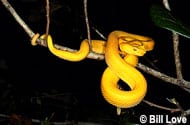Description:
This is the most polymorphic of the New World tree vipers. This venomous snake may be clad in scales of orange, various shades of yellows, olive, brown, and dull green to rich moss green. Darker or contrastingly colored crossbands, flecking, or spotting may be present. The brilliant yellow (oropel) phase and the moss green and strawberry (Christmas tree) phases are particularly coveted by hobbyists. Although a few are now being imported from “snake farming†operations in Costa Rica, the majority of those offered in the American pet trade are bred by American hobbyists. Imports and neonates can be reluctant feeders and difficult to acclimate. However, once they are feeding regularly, eyelash vipers are hardy captives. Adults usually readily accept prekilled lab mice offered on forceps. Neonates may accept a pinky mouse scented with a frog. Eyelash vipers are quiet snakes and may remain in the same position for days on end. However, they can move quickly when necessity dictates, and if frightened may either gape widely or strike quickly and accurately. Because they are a fairly small and very inactive snake, a relatively small terrarium will suffice for their husbandry. A vertically oriented terrarium of 15 or 20 gallon capacity is large enough for a pair or trio of adults. With a secure and sturdy climbing limb or two (preferably with comfortable forks), elevated corkbark hides, and a hardy live plant (such as an Epipremnum [Pothos]) a beautiful and very usable terrarium setup can be designed. As with many arboreal snakes that drink the pendulous and accumulating droplets of rain and dew from their body coils or forest leaves, eyelash vipers may not readily recognize water in a bowl as a drinking source. It may be necessary to elevate the water bowl to perch level and to roil the surface of the water with an aquarium air stone attached to a small vibrator pump. A daytime temperature of 80 to 82 degrees Fahrenheit (with a hot spot of about 85 degrees) and a nighttime temperature of 75 degrees is satisfactory. A screen top to allow air circulation is better than a glass one. Reproductive cycling is begun by dropping the cage temperatures a few degrees in winter and lowering the relative humidity for a few weeks. When the temperature and humidity is again elevated breeding often takes place. Passing storms that lower barometric pressure are also helpful in inducing breeding. A clutch contains 3 to 18 neonates.
Habitat:
This is an arboreal viper of secondary and primary rainforests. It is often seen low in shrubs and small trees along watercourses.
Range:
Eyelash vipers range southward from Chiapas, Mexico, through much of Central America, to western Venezuela, Colombia and western Ecuador.
Scientific Name: Bothriechis schlegelii
Species Group: venomous
Family: Viperidae
Size: Males, the smaller sex on this species, are adult at 14 to 18 inches in length. Females attain 24 to 36 inches.
Level: advanced
Weight:
Dangerous: No


